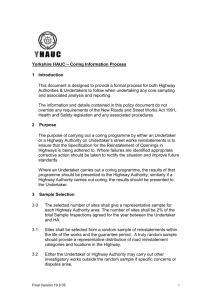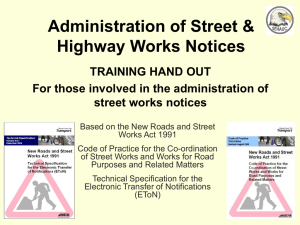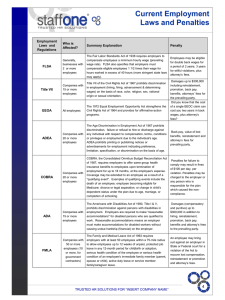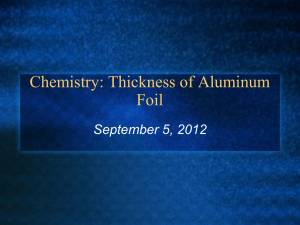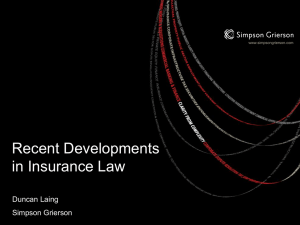CRITERIA FOR INVESTIGATORY WORKS BY CORE SAMPLING
advertisement
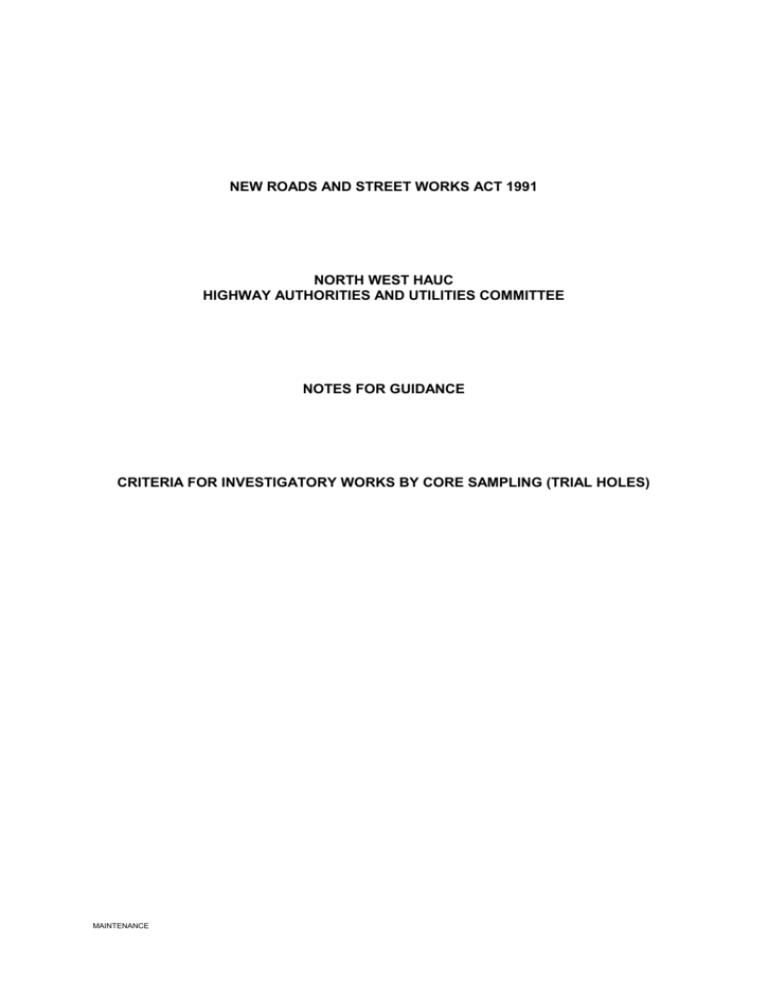
NEW ROADS AND STREET WORKS ACT 1991 NORTH WEST HAUC HIGHWAY AUTHORITIES AND UTILITIES COMMITTEE NOTES FOR GUIDANCE CRITERIA FOR INVESTIGATORY WORKS BY CORE SAMPLING (TRIAL HOLES) MAINTENANCE CONTENTS Introduction Section 1 Purpose Section 2 Sample Selection and Identification Procedure Section 3 Notification Requirements Section 4 Monitoring Investigatory Works Section 5 Validation of Testing Method and Material Testing Section 6 Performance Requirements Section 7 Core Sample Retention Period Section 8 PCSMs Section 9 Reporting Procedures Appendix A Guidelines for Compliance Appendix B Specimen Copy of Analysis Report MAINTENANCE Introduction This document has been developed to provide a framework for investigating works by core sampling. More consistent sampling and analysis methods should lead to an increased confidence in the results obtained. The document also introduces the idea that a reinstatement may contain a minor defect that does not present a safety problem for users of the highway nor is likely to affect the longevity or the integrity of that reinstatement. This is referred to as Technical NonCompliance (TNC). What does this mean in practice? A TNC reinstatement may be left in place without repair. It remains defective as defined in the Act and the Highway Authority could, if necessary, require a TNC reinstatement to be repaired at any time during its life. However, there would seem to be little point in requiring a repair unless the circumstances change and the condition of the reinstatement deteriorates. The benefits of the non-repair of TNC reinstatements are: Traffic is not disrupted by remedial work simply to correct a minor fault Money is saved Potentially damaging press and media coverage is avoided The dis-benefits of the non-repair of TNC reinstatements are: Utilities may have difficulty recovering costs from contractors if repairs are required at a later date The identity of the owner of a reinstatement may become increasingly difficult to identify over time We would encourage the use of these Guidance Notes for the management of defective reinstatements and invesigatory works. This document has been prepared and approved by North West HAUC committee members and submitted to National HAUC as best practice advice. Signed on behalf of NWHAUC MAINTENANCE CRITERIA FOR INVESTIGATORY WORKS BY CORE SAMPLING (TEST HOLES) 1. PURPOSE The purpose of this publication is: - 1.1 1.2 i) To set a framework for Highway Authorities and Undertakers whilst carrying out coring activities; and ii) To enable individual or joint coring exercises to be carried out and to provide assurances of the integrity of the results obtained. General i) It is the responsibility of the body initiating the coring activity to ensure compliance with all relevant legislation. ii) This document is primarily for core sampling but does not preclude investigation by the use of other test holes, if necessary. iii) The overall thickness of the core and each individual layer shall be measured at three points and averaged. iv) The HAUC Advice Note 1 entitled "Conciliation and Arbitration Procedure" may be initiated in the event of failure to agree. Reinstatement of Test Holes The reinstatement of test holes shall be in accordance with the HAUC publication entitled "Specification for the Reinstatement of Openings in Highways". 2. SAMPLE SELECTION AND IDENTIFICATION PROCEDURE 2.1 Sample Selection i) ii) MAINTENANCE Where the purpose of the investigatory works is to assess and determine the current performance trends, then: a) Core sample sites and positioning shall be randomly selected; b) The number of selected sites should be proportional to the level of Undertaker’s activity in any Undertaker’s area and this should be based on historic or new work information whichever best reflects the current situation; c) % split between c/w and f/w to be based on historical analysis or estimate of future work; d) Core samples should be taken on works completed in the last six months. Where the purpose of the investigatory works is to ascertain whether an Undertaker has complied with the specification under the New Roads and Street Works Act 1991, core samples may be taken by the Street Authority and/or the Undertaker, as appear to them to be necessary. Page 1 2.2 2.3 Identification i) All cores MUST be clearly identified by the Undertaker’s and/or Highway Authority’s reference numbers. ii) Reinstatements selected for coring can be identified by one or more of the following methods: a) By a circle approximately 75mm reinstatement; in diameter painted on each b) By a photograph taken showing the circle and the reinstatement in relationship to its surroundings; c) By a plan indicating the position of the reinstatement in the street. Guidance on the Frequency and Siting of Test Holes As a practical guide to reflect performance it is recommended that: i) Minimum of 1 No core sample per 10 openings or 20 square metres or part thereof; or ii) Minimum of 1 No core sample per 100 metre lengths of linear trench or part thereof. 3. NOTIFICATION REQUIREMENTS 3.1 Advance Notice of Coring Programme The Highway Authority and Undertakers should advise of each phase of their respective or joint coring programme, at least seven days prior to commencing work. For rolling programmes, longer notice is desirable. 4. MONITORING INVESTIGATORY WORKS 4.1 Investigatory Works Carried Out by Highway Authority i) The Undertaker should be invited to monitor Investigatory Works. ii) All core samples should be assessed and classified as follows: - MAINTENANCE a) Technical Compliance: Where the reinstatement meets the requirements of the HAUC specification; b) Technical Non-Compliance: Where a reinstatement does not meet all the requirements of the HAUC specification and subject to agreement, remedial works may not be necessary; and c) Defects: Where a technical non-complying reinstatement would warrant remedial works. Page 2 4.2 iii) Guidance on core sample classification as either 4.1 ii) a) or 4.1-ii) b) is contained in Appendix A. iv) The defective reinstatement defect regime (including remedial notices) shall apply to 4.1 ii) c) above). v) In the event of a technical non-complying reinstatement 4.1-ii) b) above, all reasonable costs should be recharged to the Undertaker in accordance with the Code of Practice for Inspections. Investigatory Works Carried Out by Undertaker i) The Highway Authority should be invited to monitor Investigatory Works. ii) The defective reinstatement defect regime (including remedial notices) shall apply to defective reinstatements identified by core sampling. However, defective reinstatement charges will not apply under these circumstances. iii) Undertakers are expected to carry out performance monitoring and should, as a minimum, take core samples as follows: Openings per Annum 1 1,000 10,000 50,000 4.3 to 999 to 9,999 to 49,999 and above No of Cores 50% 10% 5% 2% Removal of Non-Compliant Reinstatement Construction Once it has been decided that a core represents an area of reinstatement, which is unacceptable, unless the whole of the reinstatement is removed, further cores should be taken along the remainder of the trench/reinstatement to determine the extent of the defective areas. 5. VALIDATION OF TESTING METHOD AND MATERIAL TESTING i) Either the Highway Authority or Undertaker or their appointed/nominated third party representative may undertake the investigatory works. ii) Where sample material is tested, such tests shall comply with the relevant British or European Standard appropriate for that material and the "Specification for the Reinstatement of Openings in Highways". iii) Any requirement for analytical testing of materials should be undertaken by a NAMAS accredited Laboratory, approved to undertake such tests in accordance with the procedures of the relevant British or European Standards. iv) The advice of an approved NAMAS accredited laboratory may be sought in the event of a dispute or doubt over material specification and compliance, and reinstatement performance. v) Depth measurement (thickness) of a core sample shall be exempt from 5 ii) and 5 iii) above. MAINTENANCE Page 3 6. PERFORMANCE REQUIREMENTS 6.1 For Core Samples up to and including 100mm in Diameter i) Overall thickness or surfacing material. ii) Individual layer thickness of surfacing material. The following may be determined by mutual agreement: 6.2 Correct material; Compaction of surfacing material. For Core Samples more Than 100mm in Diameter i) Overall thickness of surfacing material. ii) Individual layer thickness of surfacing material. iii) Correct material, by laboratory test. iv) Constituent materials determined by laboratory test. The following may be determined by mutual agreement: 6.3 7. 8. Compaction of surfacing material; Correct sub-base/backfill material. Supplementary Information i) The Laboratory appointed to undertake testing may require additional cores in order to satisfy and comply with minimum sample size for analytical purposes. ii) Analytical test shall include: binder, content; aggregate grading and identification (i.e. limestone/gritstone/granite etc). iii) If the material source is known, then it is likely that the aggregate PSV values will also be known (applicable to permanent and interim wearing course only). CORE SAMPLE RETENTION PERIOD i) Highway Authority and Undertaker to be offered the opportunity of viewing the cores within three months of the presentation of results. ii) Defective core samples shall be retained until remedial works have been completed in accordance with the reinstatement specification. PCSMs Experience has shown that coring of PCSMs is difficult. Trials of alternative testing methods are being considered. 9. REPORTING PROCEDURES MAINTENANCE Page 4 i) A full report of each core sample taken shall be retained by the originator and made available if required. A typical report is shown at Appendix B. ii) A summary report of quarterly results should be presented at Regional HAUC by the relevant Highway Authority / Undertaker showing the following information: Name of Organisation Time Period covered by report Operating Unit/Area (where applicable) Footway/Carriageway (split by road type where available) Compliant/Defective % Of Total (Compliant) Total Numbers of Cores iii) A monthly summary of results shall be distributed to the relevant Highway Authority/Undertaker showing the following information: Name of Organisation Time Period covered by report Operating Unit/Area (where applicable) Footway/Carriageway (split by road type where available) Compliant/Defective % of Total (Compliant) Total Numbers of Cores Location of Each Core Wearing Course Thickness Basecourse Thickness Notice Reference Number (if relevant) MAINTENANCE Page 5 APPENDIX A GUIDELINES FOR COMPLIANCE Properties Wearing Course Aggregate Cut-Back Material Stone Size Specified Scor e 2 2 1 2 Overall Thickness Required See below Variation in Layer Thickness See below De-Bonding Compaction 2 1 2 1 2 2 1 2 2 Granular Sub-Base Criteria Limestone Aggregate Present Evidence of Flux Oils Carriageway One Stone Size Variance, e.g. 6mm to 10mm Two Stone Size Variance, e.g. 6mm to 14mm Footway Stone size larger than 6mm Within acceptable range Outside acceptable range With acceptable range Outside acceptable range De-Bonding on Clean or Dirty Surfaces Poor Compaction (Voids Present) Wearing Course Outside NWHAUC Agreement Unacceptable or Contaminated Material ACCEPTABLE INDIVIDUAL LAYER THICKNESS WEARING COURSE BASECOURSE UNBOUND MATERIAL -5mm of Specified Thickness ± 10mm of Specified Thickness ± 20mm if Specified Thickness +10mm Type 3 and 4 roads, a 25mm thick wearing course may be laid in place of the standard 40mm, provided the total thickness of basecourse and wearing course is not reduced. OVERALL THICKNESS OF BOUND MATERIAL -15mm of combined thickness of all specified layers (Roads) Minimum 100mm OVER ENGINEERING (TO AN ACCEPTABLE STANDARD) IS AT ENGINEERS DISCRETION SMALL REINSTATEMENTS PERMANENT WEARING COURSE (Type 3 & 4 Roads Only) Classification Technical Compliance [4.1 ii) a)] Technical Non-Compliance [4.1 ii) b)] Defect MAINTENANCE i.e. less than 300mm width or less than 2 square metres Two 50mm thick layers may be laid in place of standard 60mm and 40mm thickness Total for Core None One Total Two or more Total Page 6 TYPICAL LAYOUT APPENDIX B CORE SAMPLE ANALYSIS REPORT * Delete as appropriate Core Sample Reference Number: Promoter of Coring Programme: Highway Authority/Utility * Utility: District/Operational Area: Highway Authority Reference: Utility Reference: Inspection Category: Road Reinstatement Type: Date Reinstatement Carried Out: Location: Overall Dimension of Reinstatement: Date Core Sample Taken: Highway Authority/Utility Representatives on Site: Core Sample Performance: Material Aggregate Size Specification Thickness Actual Thickness Wearing Course: Base Course: Sub-Base: Other (state) ……………………: Total Thickness of Bituminous Materials: Compaction of Bituminous Materials: Compliance with Specification: Comments: Signed: ……………………………………………… MAINTENANCE Date: …………………………………….. Page 7
